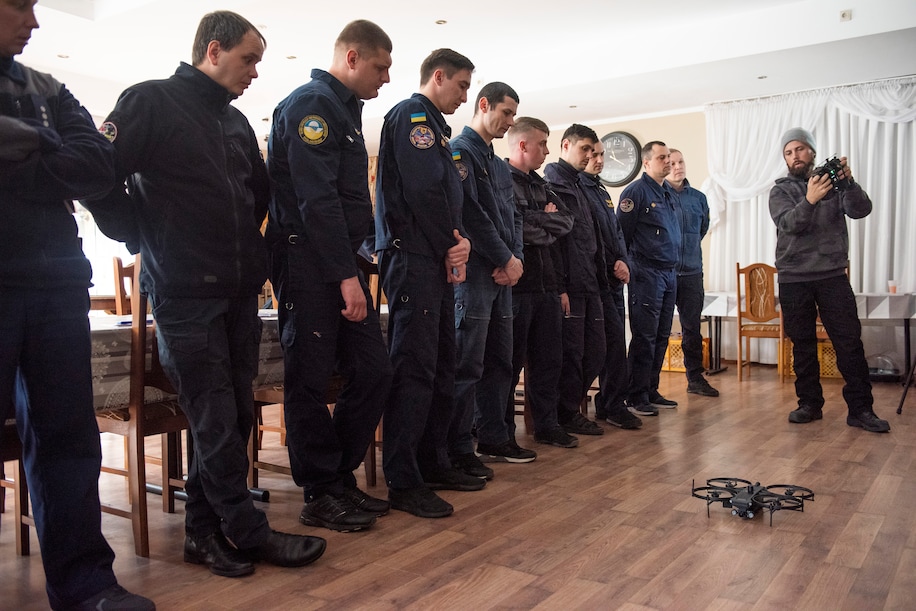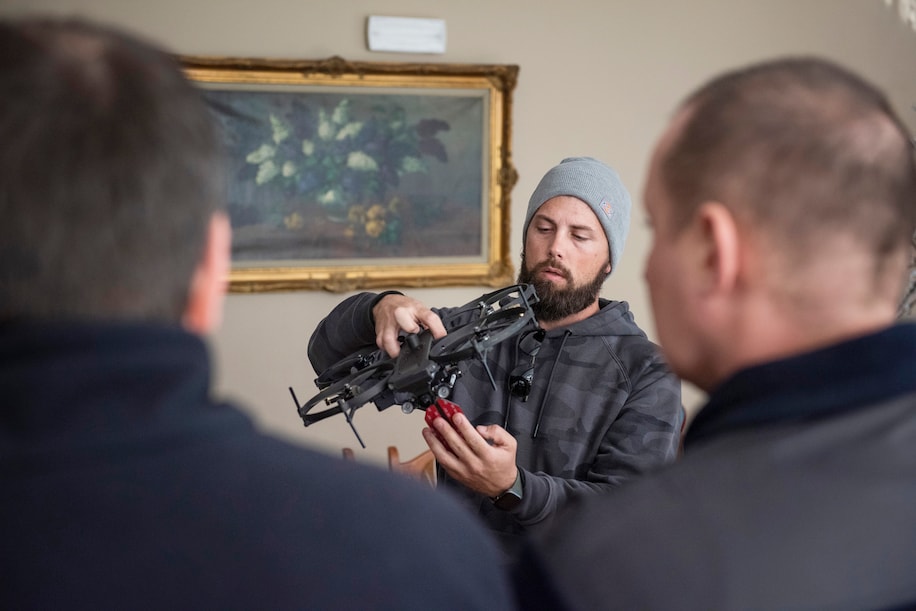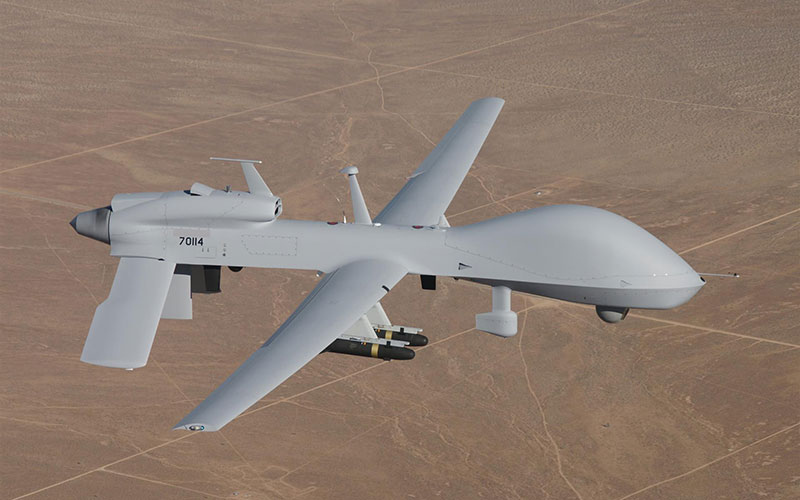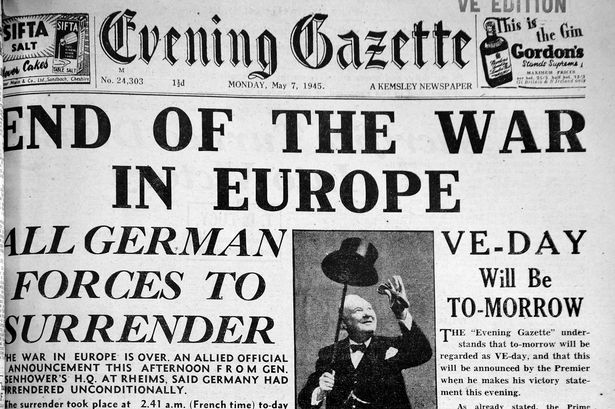[ NOTE TO READERS: In Ukraine, two wars are being waged in parallel: the real one and the virtual one. Sometimes they tally but increasingly they don’t. Neither side has the upper hand in what is becoming a static war of attrition. The stalemate may explain why Russia’s top army commanders yesterday said the war had entered “a new phase” focusing on the eastern Donbas region, where some 40,000 Ukrainian troops risk being encircled by Russian forces. I want to work through this and so I have carved out some chats today and tomorrow with my military intel connections, to do a deep dive into the present status.
In the meantime, here is my piece on drones which I updated – in a timely manner. ]
At an undisclosed site in Poland, Ukrainians train to fly drones for rescue missions and targeting Russians. An American manufacturer is providing the aircraft and teaching the Ukrainians how to operate them.
But exploding ‘kamikaze’ drones are also ushering in a new era of warfare in Ukraine. Both Russia and Ukraine are deploying so-called loitering munitions, which hunt out targets and explode on impact.
Drones have become a crucial technology for both sides.


ABOVE: Chase Bailey, a drone pilot and trainer for Brinc, explains how to use the Lemur drone to Ukrainian pilots.
26 March 2022 – – Over the past year (and intensely over the last month), Ukrainian military officers traveled secretly into Poland to practice a new wartime application for most of them: using drones to soar above ridgelines and buildings of Ukraine to peer down at enemy forces and feed targeting locations to artillery units and reconnaissance information to commanders. They were being taught by a team from Brinc, a Seattle-based drone maker. The company has donated 20 specialized quadcopters to the war effort.
NOTE: the drones are also being used to angle into the treacherous gaps of bombed-out apartments and high-rises, giving Ukrainian rescuers a better chance to reach victims. The Ukrainians hope the aircraft would make a difference in the growing hellscapes of Kharkiv, Kherson and Dnipro, Ukrainian cities where a lack of equipment and relentless attacks have made rescues difficult and perilous. There are just too many destroyed buildings and the conditions are too dangerous.
These training sessions are just part of a series of drone supplies being given to the Ukraine military from U.S. and European suppliers, part of the rapidly expanding transfer of high-tech technology, expertise and provisions to Ukraine from foreign companies and volunteers. Across Poland and other European neighbors, pop-up teams are finding ways to funnel critical resources across the border, from retrofitted vehicles and body armor to specialized orthopedic equipment and medicines.
The most beneficial, from the Ukraine military perspective, are the drones able to function at higher altitudes. Drones are already used by both sides in the war to locate enemy forces and relay targeting data back to artillery batteries. While the tiny aircraft are difficult to shoot down, their signals can be jammed and even traced back to the drone operator, who would then be the new target. It is a tricky process. But the Brinc drones have an advantage: they navigate by laser-based lidar rather than satellite-based GPS, and so they are less hackable. Last week, via TikTok, I watched the now famous tank battle wherein the Ukraine Army ambushed part of a Russian tank column. Here is a clip from the longer piece I put together (actually filmed using three drones):
Also being used: exploding “kamikaze” drones which have ushered in a new era of warfare in Ukraine. Both Russia and Ukraine are deploying so-called loitering munitions, which hunt out targets and explode on impact. I’ll look at those aspects at the end of this post.
I spoke with a U.S. military analyst (ex-U.S. Army, an expert in the use of drones for surveillance) and he told me the Ukrainians can put up a drone video armed with thermal imaging:
“I’ve seen some of the footage. It’s so chilly out there that the Russian tank crews sit with their engines running through the night. They do not have any proper equipment for winter combat. As the Ukrainian drone hovers over the woods in the blackness, it picks out the Russian tanks hiding in the cold. Each Russian exhaust spills its presence, white on black. Then Ukrainian artillery, pinpointed by the drone, moves in for the kill and takes out each white dot, one by one, using the drones geolocation software. Sometimes they can use “killer drones” which work in pairs. The drones are integrated with sensor-to-shooter software that enables instant transfer of target coordinates from the surveillance drone to the shooter drone, armed with bombs or mini-missiles, coordinated by the drone operator, so he can easily and quickly pick off targets”.
There are also more sophisticated drones, designed for pinpoint strikes that have a remarkable feature called “waved off” capability to prevent collateral damage. For example, the operator can adjust the blast radius so the drone kills only the driver of a vehicle but not a passenger. And some of these drones cost as little as $6,000.
My military contact also noted:
“Ukraine has made terrific use of Turkish Bayraktar TB2 unmanned aerial vehicles, which can loiter over tanks and artillery and destroy them with devastatingly accurate missile fire. I know the Pentagon is working to help keep those drones flying. Ukraine received a new shipment of those drones this month. It is literally a World War I aircraft, in terms of performance. It’s got a 110-horsepower engine. It is not stealthy. It is not supersonic. It’s a clay pigeon – a real easy target. Military experts (me included) predicted that Russian forces would have little trouble dealing with Ukraine’s complement of these Turkish drones.
But, as so often has been the case in this war, however, we misjudged the competence of the Russian military. I mean, it is quite startling to see all these videos of Bayraktars apparently knocking out Russian surface-to-air missile batteries, which are exactly the kind of system that’s equipped to shoot them down. That is confounding, because the drones should be easy for the Russians to blow out of the sky — or disable with electronic jamming”
If nothing else, said another military source, the Russians should be able to down the drones with fighter jets. But without air superiority, Russia hasn’t been flying regular combat air patrols. As for electronic jamming, one of the mysteries of the Ukraine invasion is why the Russians haven’t made more use of what experts believe is their advanced electronic warfare capability. The Pentagon is quickly learning what the Russian military cannot do. The bottom line is that the Turkish drones continue to star in videos shared across Twitter and other social media platforms that feature them blowing Russian vehicles to smithereens. Ukrainians have even praised them in song.
And, of course, as I have written before, there is the “swarm intelligence” aspect – seen in the Afghanistan, Iraq and Yemen wars but not yet in Ukraine. This centers on swarm drones technology – the ability of drones to make decisions autonomously based on shared battle/flight information. It has revolutionised the dynamics of warfare. Swarms of drones are also capable of conducting operations against vast areas in order to detect and eliminate enemy surface-to-air missiles, enemy surveillance/control radars and other net-centric air defence structures. It is even feasible on the homeland security front (according to the U.S. Homeland Security Model) for drone swarms to be equipped with chemical, biological and nuclear detectors, but also with integrated facial recognition algorithms in order to conduct counter-terrorism operations against potential radical targets inside and outside the territory (the above-mentioned procedure was used extensively in Syria in 2011-2014).
NOTE: the Ukraine Army is using integrated facial recognition technology to identify dead Russian soldiers and I’ll address that next week in a separate post.
While drones already have a long pedigree in surveillance, a rise in insurgent attacks and an unwillingness to put “boots on the ground” has resulted in an overwhelming demand for drones with advanced direct combat capabilities. In the past decade, the deployment of hunter-killer drones has grown exponentially so that they have come to symbolise the “War on Terror”. I have been fascinated by the technology for several years, and I wrote a monograph about two years ago. I actually got pulled into drone technology way back in 2010 when I was following the Bradley Manning story and his leaks which included full transcripts of drone operators discussing attacks, plus the corresponding drone videos, which showed the unjustified massacre of civilians in Iraq and many unprovoked attacks on journalists, the most infamous being the direct targeting and killing of Reuters journalists in 2007.
What follows is part of that monograph on drones, just a short history to provide you some perspective.
Drone technology spans a century’s worth of science fiction and military research

The MQ-9, the primary offensive strike unmanned aerial vehicle for the U.S. Air Force. It is one of the most advanced drones given its significant loiter time, wide-range sensors, multi-mode communications suite, and precision weapons.
A war exists across, within, and between multiple locations of sight and violence – lived war experiences and subjectivities that accompany visual modes, configurations. Up to the point of the Manning leaks, the ubiquitous and predominant viewpoint was from the U.S. government. Journalists had stories of atrocities and witnesses who countered many of the narratives spilled from the government, but little hard proof. The Manning revelations changed that.
You need to start with two classics: Drone: Remote Control Warfare by Hugh Gusterson who writes of drone warfare from the perspectives of drone operators, victims of drone attacks, anti-drone activists, international law, military thinkers, and others. It is considered the “go to” book you start with to wrap your mind around the field. And A Theory of the Drone by Grégoire Chamayou which seeks to comprehend how drones have revolutionised contemporary warfare and deconstructs the various narratives at the heart of what has become a conceptual and legal dilemma. It is a masterful read, and helps elucidate much of the twisted logic behind the justification of drones as well as their long-term revolutionary impact on modern conflict.
The following is a mash-up of those two books, but it also incorporates notes from the Herzog webinar lectures on drone warfare I attended, and my conversations with drone operators when I was invited to attend a course on “Surveillance & Communications” at the United States Army War College in Carlisle, Pennsylvania.
When the U.S. invaded Iraq in 2003, there were only a handful of aerial drones in its invasion force. By 2010 the Pentagon had nearly 7,500 drones in its arsenal. Today almost one in three U.S. military aircraft does not have a pilot. This technological revolution has been driven by the use of weaponized American drones, especially the Predator and Reaper.
Despite the futuristic concept of robotic air warfare, drone technology goes back a hundred years. The technological groundwork was first established by Nikola Tesla, who introduced radio-control technology at Madison Square Garden in 1898. Tesla immediately realized his invention’s military potential, noting that the technology would allow man to build devastating remote weapons that would be a deterrent so inhuman and destructive that, in his imagination, they would “lead to permanent peace between the nations.”
That moved Archibald Montgomery Low, a British engineer, who recognized the potential of marrying airplanes with wireless transmission. At the beginning of World War I, he won a commission to build a remotely piloted weapon to destroy German Zeppelins. He experimented with numerous designs but had little success, crashing various prototypes. While Low was able to demonstrate that planes could be steered with Tesla’s radio waves, his anti-airship weapon never got close to production. Since the devices were designed to self-destruct, the concept was in most ways closer to modern rockets or cruise missiles. Nevertheless, Low’s machines can be seen as the earliest precursors of combat drones.
A continent away, another inventor was also working to keep unpiloted aircraft safely airborne. Elmer Sperry had widespread interests that ranged from recycling tin from scrap metal to developing searchlights for the U.S. Navy. Fascinated by the idea of remotely steered and even fully autonomous planes, he realized the need for an effective stabilizing mechanism. Supported by the navy, Sperry started experimenting with gyroscopes. First tests showed promise in 1915, and Sperry joined forces with engineer Peter Cooper Hewitt to develop an “aerial torpedo,” a small pilotless aircraft filled with explosives.
Less than a year later they were ready to demonstrate a prototype to T.S. Wilkinson of the navy’s Bureau of Ordnance. The machine consisted of a winged frame that was launched by catapult. Aided by a precision barometer, it climbed to a prescribed height. Once it had reached its final altitude, a mechanical counter calculated how far the aerial torpedo had to fly to reach its target. The device could then be set to drop a bomb or crash and explode on impact. While the advantages of not putting pilots’ lives at risk during missions must have been apparent, the navy was not impressed with the accuracy of Sperry’s invention. But as the U.S. was about to join World War I, Sperry was able to convince the U.S. government to sink several thousand dollars into developing a system that could fly by autopilot or be steered by radio control. The navy saw its potential in assaults on heavily guarded submarine bases like the German base at Helgoland Island.
But, there were issues. As we all know, technology advancement does not run linear. One problem was the launching device. Catapults and railroad tracks were used, but both proved to be problematic. Difficulties with getting the machines airborne obscured another complication: the aerodynamic quality of the airframe was inadequate. After several botched launches, Sperry realized he had to pay more attention to the plane’s design. He had a prototype based on the hydroplane Curtiss N-9H fitted with a pilot’s seat and a stick control. In a dangerous act of brinkmanship, the inventor’s son tested the configuration. During the first takeoff, Lawrence Sperry flipped the airframe and wrecked it.
While the aerial torpedo never came close to contributing to the war effort, U.S. Air Force had become hooked on drone technology. It tapped Charles Kettering to build a winged autonomous vehicle armed with a warhead, what would later be known as the “Kettering Bug.” Early prototypes of the device were made out of a material like papier mâché, later ones out of wood. Like Sperry’s machines, they were stabilized by a gyroscope. The autopilot consisted of flight instruments rigged to cranks and bellows gutted from a player piano. The gadget could cast off its wings to swoop down on a target. The project also recruited engineers Elmer Sperry … and a guy named Orville Wright.
As the tests proceeded, the Air Force realized that its engineers lacked a solution to the problems that had stymied the development of the aerial torpedo. During a demonstration, Kettering’s team escaped a catastrophe when the bug spun out of control and narrowly missed the reviewing stands. Then Spanish Flu incapacitated the team. The armistice went into effect. The Kettering Bug never flew a single mission.
That unmanned aerial vehicles re-entered the arsenal of the U.S. military is to a large part due to the ingenuity of an unlikely arms manufacturer: British actor Reginald Denny, one of the stars of Hollywood’s silent era. With a pencil mustache, a wide grin, and an angular physique, he appeared in light comedies, typecast as a jolly but slightly dimwitted Brit. A former member of the World War I Royal Flying Corps, Denny was an airplane enthusiast who became intensely interested in toy airplanes. His interest in these toys developed, as he later told the story, from a chance encounter with a boy trying to get his toy plane airborne. Offering to help, Denny accidentally crashed and wrecked it. Shopping around for a suitable replacement for the boy, the actor became hooked on flying model aircraft.
In the 1930s toy planes were made from balsa wood and commonly powered by rubber bands, and they didn’t fly particularly far. Denny started tinkering and became intrigued by the technology, which was shared by fellow actors Jimmy Stewart and Henry Fonda. Denny even set up his outfit, the Denny Radioplane Company. From a shop on Hollywood Boulevard he sold models that looked like scaled-down planes. More upmarket models were powered by a miniature engine, designed by engineer Walter Righter, from whom Denny had acquired patent rights.
Eventually, the actor hit upon the idea of manufacturing radio-controlled model aircraft that could be used as targets to train antiaircraft gunners. He proposed the idea to the U.S. military but received a lukewarm response. Yet with the start of World War II, he was asked to mass-produce these drones. In the following years, Denny’s company morphed into a million-dollar business, turning out thousands of flying targets. Launched by a catapult, these drones were remote-controlled by an operator who steered them into the range of antiaircraft guns. They had one feature that was completely new: since they were rigged to a parachute, they were reusable. For this reason, the Denny radioplane OQ 2 was the first mass-produced unmanned aerial vehicle in the sense that we know it today. All other similar devices, until then, were built to self-destruct. As the radioplane company blossomed, it hired more staff. Since men were being drafted to fight, women were hired to work on the production line.
A fascinating side-note: in 1944 Norma Jean Dougherty, the future Marilyn Monroe, was doing shifts at the Denny site near the Burbank airport. As it happened, photographer David Conover was assigned by Army magazine “Yank” to promote the Denny radio-plane factory – dispatched by his commanding officer, none other than Ronald Reagan.
Conover spotted Dougherty and asked her to pose with the propeller of a drone. She had never posed or done any type of camera work in her life. The photographer persuaded her to model, and had her do several more photo shoots for the Denny radio-plane factory. Conover suggested they shoot morale-boosting pictures of female workers, using Dougherty. Although none of her pictures were used, the Denny adverts were seen by a Hollywood modelling agency who signed Dougherty to a modelling contract in August 1945. The agency deemed Monroe’s figure more suitable for pin-up than high fashion modeling, and she was featured mostly in advertisements and men’s magazines. To make herself more employable, she straightened her hair and dyed it blonde and according to Conover “she became one of the agencies most ambitious and hard-working models”. It was the first stop to her career as an actress.
A separate World War II–era drone program was driven by grave threats emerging from Nazi Germany. As early as mid-1940, Nazi engineers had started developing long-range artillery weapons so novel and secret that they were only referred to as Vergeltungswaffen, or reprisal weapons. The sites where these munitions were built were heavily guarded and assaulting them with bombers came at a deadly risk. Sometime in September 1943, aerial photographs reached Allied High Command showing the Nazis had begun building an elaborate structure near the hamlet of Mimoyecques in the Pas-de-Calais:
• More than one thousand workers, many of them prisoners, were involved in excavating a labyrinthine system of tunnels.
• Above ground, military trucks arrived, delivering mysterious pipes and metal rails. Allied analysts concluded that the site was designated as a launching site for the V1 rocket.
• In fact, the device was something even more devastating. Code-named Fleissiges Lieschen, or Busy Lizzie, it was to be the world’s most powerful supergun, designed to shell London with an incessant barrage of explosives. Instead of sending bombers to the British capital, Hitler planned to pummel the city with hundreds of rounds per hour.
After more than a dozen attacks on the site, the Allies had suffered such heavy losses that they decided to deploy a revolutionary new weapon. Project Anvil promised to accomplish something seemingly impossible: kamikaze attacks on the enemy without the loss of a pilot. The concept involved gutting battle-fatigued PB4Y-1 Liberator and Fortress bombers and furnishing them with a system of pulleys and motors that allowed a crew flying in an accompanying plane to pilot them remotely with a radio linkup.
The most innovative element of these drones, though, was a television camera that relayed live images from the nose cone to operators in the chaser plane. Television was a new invention, not yet widely available in the consumer market. Cameras in Project Anvil were used to guide the way to enemy targets where the behemoths were made to crash, causing tons of Torpex, a high explosive stacked in their bellies, to detonate.
Despite their lethal potential, the unmanned flying machines had one drawback: they could not take off on their own. Pilots were required inside the crafts to get them airborne and on course. Once they had been pointed in the direction of their target, the pilots would activate the remote steering system and bail out by parachute.
In the case of the bombing of Mimoyecques, the U.S. Navy selected a man who was uniquely suited for this task. Born in 1915, Joseph “Joe” Kennedy was the older brother of John F. Kennedy. He volunteered for hazardous missions in Britain, helping to clear the North Sea of German submarines. Though he qualified for leave, he volunteered to take part in the drone attack on the Nazi supergun site. On August 12, 1944, Kennedy and experienced weapons officer Wilford John Willy boarded a liberator drone and taxied the aircraft out on the runway. The hold was loaded with a deadly cargo of 10.6 tons of Torpex. As they took off, eight airplanes joined them: four were armed Mustangs, a security detail, two Mosquitos carrying observers, and a further two Venturas, each fitted with a set of remote controls to pilot the drone in case one of the devices failed. As they approached the British coast, lieutenant Willy started arming the charges. He also activated the “block,” the code name for the television camera. Once he had completed his round, both pilots readied themselves to bail out. Kennedy pulled up the drone to an altitude of 600 meters. When the plane had reached its prescribed altitude, he radioed “zoot suit,” code that all was ready. Two minutes later the drone exploded. The blast was so powerful that the debris was scattered across an area spanning more than two miles. Most parts rained down on New Delight Wood, a dense English forest that immediately caught fire. The flames caused damage to 147 properties. Kennedy and his copilot were killed instantly. The most likely reason for the crash, experts concluded, was that an electronic pulse from the TV camera unit triggered the fuse of one of the charges. Whatever the cause, Project Anvil was suspended.
A rival U.S. program in the Pacific proved to be more successful, the assault drones having inner workings that were more state of the art, including radio control, a TV camera, and a radar-tracking device. The unit made twenty-one direct hits on targets. More important, no American was killed during these raids, underscoring the potential of the weapon.
After the war, the advent of long-range bombers and ballistic missiles, military planners lost interest in armed drones. But while the military’s appetite for drones was waning, popular culture was flooded with killer machines. In the 1953 film Robot Monster, an android attempts to annihilate the last living family on earth. In Target Earth (1954) robots from Venus invade planet Earth, and in Kronos (1957) aliens send a gigantic robot to earth to suck dry its energy supply.
Though 1950s technology could not come close to what was being imagined by filmmakers and writers of pulp fiction, this changed in the early 1960s, following several shoot-downs of U2 and B-47 spy planes by the Soviets. These events made the U.S. military and the CIA realize its manned reconnaissance missions were increasingly risky. The Soviet Union’s antiaircraft missile defense had upgraded so substantially that it had become unsafe to breach its airspace. So the United States dramatically accelerated the development of new drones, culminating in the Lightning Bug, a UAV that was fitted to sniff out Soviet nuclear-missile sites.
Then, the Vietnam War saw the first large-scale use of drones in combat, with, on average, one mission flown each day. Meanwhile, the navy experimented with a helicopter drone, the DASH QH-50, which was sent to Vietnam to spot artillery targets and hunt submarines. A configuration was imagined that would have allowed the drone to deliver a tactical nuclear bomb, though deployment was never attempted. During its first few decades of service the drone proved to be a capricious piece of equipment, with 441 of them lost, mostly due to technical failure.
But the Cold War was heating up, spying missions becoming more ambitious, and this all culminated in the development of supersonic reconnaissance drones. The most enigmatic of these machines was the gargantuan Soviet Tupolev Tu-123, a modified cruise missile bristling with cameras and electronic sniffers. This system was especially expensive since it was not reusable and had to be ditched after every sortie.
NOTE: according to research conducted by Hugh Gusterson, to this day it is unknown what scouting missions were conducted with the craft and it is lucky that it was never detected, since the West’s early warning line would almost certainly have interpreted its frame and flight pattern as being that of an inbound Soviet nuclear missile.
And so, forty years later, drones have become ubiquitous and powerful than ever. This is due to advancements made by Israeli engineer Abraham Karem, who invented the durable airframe that was to become the feared Predator. His updated drones met an emerging, insatiable demand. Proponents of drone technology, especially the U.S. and Israel, see themselves under threat of “asymmetric” incursions, especially terrorist attacks. In such conflicts, gathering intelligence in real time is considered just as crucial as the military might of tanks and cannons.
Meanwhile global positioning systems, developed as a military technology in the 1970s, have made drones considerably more accurate. With a network of satellite relay stations like the U.S. base in Ramstein, Germany, drones can be piloted from bases halfway across the globe. High-resolution video cameras and new signals-intelligence technology have also increased drone capabilities, with drones able to track and target individual cell phones even after they have been turned off and the battery removed. Today, military drones both eavesdrop on everything from phone conversations to emails and perform “hunter-killer” missions.
While the public is grappling with the ethical implications of remotely piloted drone campaigns, new challenges have loomed on the horizon. As the technology has advanced, drones have now been developed to be increasingly autonomous. If you’ve followed any of these developments in the media, it’s tagged as “death by algorithm”. Worse, as noted in a long piece in Defense One, (one of the primary blogs to follow for developments in advanced military technology), the U.S. Air Force sees the possibility of aerial combat between fighter drones flying at incredible speeds, requiring maneuvers at such speed that a human pilot is simply too slow to respond.
And despite all the talk of “precision”, these precision weapons are not all they are made out to be. Civilian deaths in Pakistan and Afghanistan are substantial. According to a leaked cache of government files, 90 percent of fatalities in one U.S. operation in Afghanistan over a five-month period in 2012 and 2013 were other than the intended targets, and by 2017 that had been reduced to *only* 75%. According to the leaked Manning documents, targets are referred to as “objectives” and kills as “jackpots”; people killed other than the designated target are referred to as “EKIA,” enemy killed in action, even if no connection to the target is established.
And another study by a Pentagon task force noted that in the campaigns in Yemen and Somalia, drones, limited by fuel and available bases, sometimes spend half their time in transit to surveillance targets, making the drone war expensive and inefficient. This is summarized by the authors of the study as a cause of the “tyranny of distance” that results from waging war from remote bases.
Last point, made by a member of the U.S. military in the webinar I noted above: though drones can hover above an enemy – capturing electronic communications, tracking the movement of a target – enemies are becoming more savvy, more elusive. An army with troops on the ground can interrogate captured combatants and collect human intelligence. Pursuing an enemy purely from the air, however, gives commanders little of what is really going on. He said there maybe a political unwillingness to put “boots on the ground” but it is as necessary as ever.

Kamikaze drones are showing up in bigger numbers in Ukraine
Recently photos surfaced on social media of a roughly four-foot-wide tan, airplane-shaped drone that had fallen out of the sky in the Kyiv region, crashing into the sandy ground. While that one failed to explode on impact, the images verified by my OSINT contacts provide some of the first evidence Russia is using a new and terrifying weapon in its war against Ukraine: a killer drone that can dive bomb into targets, destroying them with little notice.
The Russian kamikaze drones, also known as loitering munitions have been joined on the battlefield by ones sent to Ukrainian forces by the United States, making the war the largest direct conflict between two countries in which they’ve been deployed on both sides. Researchers who specialize in the field say it shows that these drones are becoming the norm in modern warfare, and are likely to make the conflict more deadly and unpredictable. It’s going to be more of a psychological effect. There’s no place to hide.
As I have noted in my Ukraine War series, Russia’s 24 February invasion and the ensuing war has already been a proving ground for high-tech weaponry. Ukrainian troops have used portable antitank missiles to destroy countless Russian vehicles, while social media has been used by Russia’s government to try to muddy the facts on the ground with disinformation. On TikTok and Twitter, regular people around the world have been verifying photos of Russian troop movements and reporting them to Ukrainian authorities to aid in the war effort.
Drones have also played a key role in the war. As I noted above, Ukraine’s Turkish-made Bayraktar TB2, the size of a small airplane and equipped with laser-guided missiles, is wreaking havoc on Russian tanks and trucks and helping to stymie the invasion. There’s some evidence Ukraine might also be using the Polish-produced Warmate drone – which can be reused as a surveillance drone or equipped with explosives to become a loitering munition. Wim Zwijnenburg, a drone expert with Dutch arms control NGO Pax, has been posting reams of good stuff across social media.
The smaller, exploding drones now in use by both Russia and Ukraine differ from older, more traditional drones. Instead of taking off, launching missiles and then returning to a base, they fly above the battlefield and turn into missiles themselves, divebombing vehicles or groups of soldiers and exploding on impact. Some can be carried in a backpack and launched in the midst of combat, making them especially deadly in urban or guerrilla warfare.
Generally they are cheaper and easier to use, too. The Russian KUB-BLA drones spotted in the Kyiv area can fly 30 minutes at 80 miles per hour before hitting a target. The Switchblades en route to Ukraine from the U.S. are even smaller, and can fly themselves while an operator looks through a video feed to choose a target.
Most loitering munitions are still human-controlled, but could be upgraded with software that allows them to pick their own targets. That’s generated concern among arms-control experts who worry about allowing computers to make decisions about who to kill, something that could lead the world toward a future where deadly, autonomous weapons are the norm in both big and small conflicts.
NOTE: loitering munition drones have been used in many recent wars: Afghanistan, Iraq, Libya, Somalia, Syria, Yemen. They were instrumental in Azerbaijan’s defeat of Armenia in the 2020 war between the two countries.
Russia’s invasion started with long-range cruise missiles slamming into Ukrainian cities, power plants and military bases. Long columns of tanks and trucks rolled over the border, but were quickly slowed down by supply issues and stiff resistance from Ukrainian troops. Now, Russia has settled into surrounding Ukraine’s cities, bombarding them with missiles and artillery guns. Though both sides are using loitering munitions, they could be especially useful to Ukrainian forces, who are using smaller teams of troops moving quickly around the battlefield in vehicles to hit Russian tanks and defensive positions before pulling back to safety, the experts said.
NOTE: the U.S.-made Switchblades are easier to hide and can be moved quickly. They also increase the range at which Ukrainians can target Russian enemies, allowing them to disable command and control vehicles in the field and target high-value Russian targets … like generals.
As war loomed, the U.S. began arming Ukraine to hit Russian aircraft, tanks and also prep for urban combat, and insurgency, based on declassified shipment lists and OSINT revelations. It makes sense. All those things are very, very useful for insurgents. You can do a lot of really damaging stuff, especially if you use them smartly. Those small, mobile squads have already proven adept at taking out Russian tanks and trucks with portable antitank missiles like the U.S. Javelin and British NLAW. The Switchblades will only make them deadlier.
And the increased use of loitering munitions is having an effect that goes beyond the specific instances that they’re actually used. U.S. military intelligence has picked up numerous conversations that confirm some Russian troops, facing Ukrainians armed with deadly high-tech weapons and suffering staggering casualties, are losing the will to fight. Loitering munitions could make that worse.
It is an amazing technology. The Switchblade, in particular, is specifically designed to engage targets in concealed locations. Loitering munitions reduce the time it takes to identify, locate and kill a target, and they are hard for an enemy to detect, giving off little heat signature. In urban combat, where the distances are short and you’re up close and personal with your adversary, closing that kill chain more quickly can be the difference between life and death.
And the obvious: the widespread rollout of loitering munition drones has led some of the warfare experts to warn about the potential for these tools to fall into the wrong hands, like terrorists. They’re particularly useful for assassination attempts such as when Venezuelan President Nicolás Maduro was unsuccessfully targeted by two Chinese made DJIM600 drone’s strapped with C-4 explosives.


